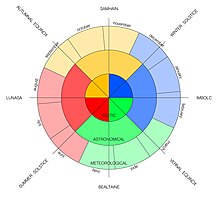Quarter days
In British and Irish tradition, the quarter days were the four dates in each year on which servants were hired, school terms started, and rents were due. They fell on four religious festivals roughly three months apart and close to the two solstices and two equinoxes.
The significance of quarter days is now limited, although rents for properties in England are often still due on the old English quarter days.
The quarter days have been observed at least since the Middle Ages, and they ensured that debts and unresolved lawsuits were not allowed to linger on. Accounts had to be settled, and a reckoning had to be made and publicly recorded on the quarter days.[1]
In England
[edit]Assuming you can remember when Christmas occurs, a useful mnemonic to place the remaining quarter days is to count the letters of the relevant months. Thus, in March, there being five letters, you can know that the quarter day is the 25th. June has four letters and the quarter day is the 24th, and September, having nine letters, has its quarter day on the 29th.[2]
G. C. M. Young, The Times, 2006
The English quarter days (also observed in Wales and the Channel Islands) are:
- Lady Day (25 March, the Feast of the Annunciation)
- Midsummer Day (24 June, the Nativity of St John the Baptist)
- Michaelmas (29 September, the Feast of St Michael and All Angels)
- Christmas (25 December)
Falling close to the Spring equinox, Lady Day was the first day of the civil year in England, Wales and the British dominions (but not Scotland) until 1752 (when it was harmonised with the Scottish practice of 1 January being New Year's Day). The British (personal) tax year still ends on "Old" Lady Day (5 April under the 'new style' (Gregorian) calendar, which corresponds to 25 March under the 'old style' Julian calendar: the Calendar (New Style) Act 1750 advanced the calendar by eleven days. 5 April is still the end of the British tax year for personal taxation.
The cross-quarter days are four holidays falling in between the quarter days: Candlemas (2 February), May Day (1 May), Lammas (1 August), and All Hallows (1 November).
At many schools, class terms would begin on the quarter days; for example, the autumn term would start on 29 September, and thus continues to be called the Michaelmas term, especially at more traditional universities.[3]
In Ireland
[edit]
Prior to the Christianisation of Ireland in the 5th century AD, the Celtic quarter days were observed:[4]
- Imbolc (February 1)
- Beltaine (May 1)
- Lughnasadh (August 1)
- Samhain (November 1)
These are now called cross-quarter days since they fall about halfway into each of the English quarters.[5]
Since 2022, when a holiday for Imbolc was added to the list, all four traditional Celtic quarter days are now marked in the Republic of Ireland by an annual public holiday.[6]
In Scotland
[edit]The "Old Scottish term days" corresponded approximately to the old Celtic quarter days:
- Candlemas (2 February)
- Whitsunday (legislatively fixed for this purpose as 15 May)
- Lammas (1 August)
- Martinmas (11 November).
These were also the dates of the Quarter Days observed in northern England until the 18th century.[citation needed]
The dates for removals and for the employment of servants of Whitsunday and Martinmas were changed in 1886 to 28 May and 28 November respectively.[7] The Term and Quarter Days (Scotland) Act 1990 redefined the "Scottish term days", in official use, as:[8]
- 28 February,
- 28 May,
- 28 August and
- 28 November.
The Act specifies that the new dates take effect on 13 June 1991 (12 months from the date it was passed). Thus the Scottish term days, as days on which rents are paid, correspond more closely to the cross-quarter days than to the English quarter days.
See also
[edit]Notes and references
[edit]- ^ Clines, David J. A. (1998). On the Way to the Postmodern: Old Testament Essays, 1967-1998 (Continuum International Publishing), p. 801.
- ^ Young, G. C. M. (15 April 2006). "Quarter days". The Times. London: Times Newspapers. Archived from the original on 11 June 2019. Retrieved 11 June 2019.
Assuming you can remember when Christmas occurs, a useful mnemonic to place quarter days is to count the letters of the relevant months. Thus, in March, there being five letters, you can know that the quarter day is the 25th. June has four letters and the quarter day is the 24th, and September, having nine letters, has its quarter day on the 29th.
- ^ Staff (9 October 2013). "Lectures and Seminars, Michaelmas term 2013" (PDF). Gazette Supplement. Oxford University. p. 1. Archived (PDF) from the original on 10 January 2015. Retrieved 24 June 2014.
- ^ "What are Quarter Days and Cross-Quarter Days?". Learn Religions. Retrieved 13 January 2021.
- ^ Rothovius, Andrew E. (29 November 2023). "Ancient Celtic Calendar: Quarter Days and Cross-Quarter Days". The Old Farmer's Almanac.
- ^ "Government agrees Covid Recognition Payment and New Public Holiday". www.gov.ie. 19 January 2022. Retrieved 25 August 2023.
- ^ Mairi Robinson (chief ed.): The Concise Scots Dictionary, Aberdeen University Press, 1985
- ^ "Term and Quarter Days Act (Scotland) Act 1990, Section 1". Government of the United Kingdom.
| Sovereign states |
|
|---|---|
| States with limited recognition | |
| Dependencies and other entities | |
| Other entities | |
Text is available under the CC BY-SA 4.0 license; additional terms may apply.
Images, videos and audio are available under their respective licenses.
